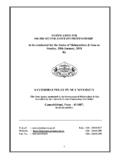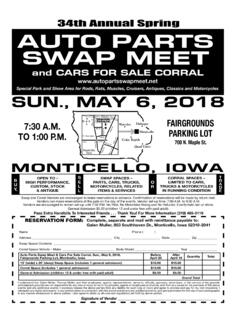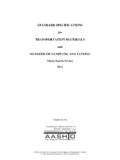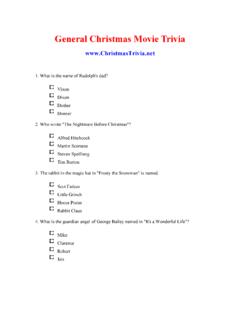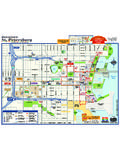Transcription of Critical Review Report - WHO
1 34th ECDD 2006 ketamine Critical Review of ketamine Introduction During its meeting in September 2002 the WHO Expert Committee on Drug Dependence did a pre- Review on ketamine (WHO, 2003). Based on the available information a recommendation was given for a Critical Review of this substance. In about the same periode both in The Netherlands (CAM, 2002) as well in The European Union (EMCDDA, 2002) separate Risk Assessment procedures for ketamine were performed, concluding that there was no need to tighten the current systems for control of this substance, as a pharmaceutical product. The information used in the three abovementioned procedures (meanwhile published) has been the starting point for this Critical Review Report .
2 A Review of pharmacological and toxicological data prepared by Dutch experts (Van Aerts and Van der Laan) has been used (with their permission) for the relevant parts of this Report . In addition to these data an online computersearch has been performed in the following databases Pubmed, Toxline, Psycinfo and Embase. Conclusions ketamine is an arylcycloalkylamine structurally related to cyclidines, like eticyclidine, phencyclidine, rolicyclidine and tenocyclidine. It is a NMDA-receptor-antagonist used as an anaesthetic in both human and veterinary medicine. Furthermore a number of effects on various neurotransmitter systems have been described. ketamine can produce a state of dependence as shown in various animal models. This is supported by some human data as reported by the WHO. Although one should keep in mind that monitoring of adverse effects in patients is quite different from monitoring effects in recreational users.
3 Due to its pharmacological effects it produces a depression of the central nervous system, resulting in hallucinations, disturbances in thinking and perception and also in motor function. There is evidence that ketamine is abused, but looking at the figures one can hardly consider this to constitute a public health and social problem. Especially when comparing ketamine to the other cyclidines. The substance is difficult to synthesize, so illegal production is unlikely. Preparations are mainly used in hospitals and veterinary clinics, so it is not expected that diversion will take place on a large scale. Summarizing all the available information international control is not really necessary, but keeping the drug under surveillance could be considered. - 1 - 34th ECDD 2006 ketamine 1.
4 Substance identification INN: ketamine , ketamine hydrochloride; Chemical names: 2-(2-chlorophenyl)-2-(methylamino)cycloh exanone hydrochloride; 2-(o-chlorophenyl)- 2-(methylamino)cyclohexanone hydrochloride; 2-(methylamino)-2-(2-chlorophenyl)cycloh exanone hydrochloride; 2-(methylamino)-2-(o-chlorophenyl)cycloh exanone hydrochloride; cyclohexanone, 2-(2-chlorophenyl)- 2-(methylamino) hydrochloride; cyclohexanone, 2-(o-chlorophenyl)- 2-(methylamino) hydrochloride; Research names : CI-581; CL-369; CN-52,372-2. CAS Number : Free base: 6740-88-1 Hydrochloride salt: Current: 1867-66-9; Previous: 81771-21-3; 96448-41-8; 42551-62-2 Proprietary names: Anaket, Anasket, Anesketin, Brevinase, Brevinaze, Calypsol, Calypsovet, Chlorketam, Imalgene, Inducmina, Kalipsol, Katalar, Keta, Keta-HamelnKetaject, Ketalar, Ketalin, Ketalor, Ketamav, Ketamax, Ketamil, Ketaminol Vet, Ketanarkon, Ketanest, Ketanest-S, Ketaset, Ketasol, Ketava, Ketaved, Ketavet, Ketmine HCl, Ketolar, Ktmin, Narkamon, Narketan, Pan- ketamine , S-Ketamin, Tekam, Vetalar Vetaket, Vetus Ketha-Thesia.
5 Street names A number of street names for ketamine can be found in the literature, like: ketamine , K, K-Hole, Kaddy, Kate, Ket, Vitamin K, Special K, Super K, K ta K, Kit Kat, Cat valium, Liquid E, Liquid G, Flatliners, Tac et Tic, Jet, Super acid, 1980 acid, Special LA coke, Super C, Purple, Mauve and Green (EMCDDA, 2002; Nabben and Korf, 2000; Pagliaro and Pagliaro, 2004). Some names clearly refer to the veterinary origin of the product. One should be aware of the fact that street names are not always exclusive for just one substance. Flatliners is also used for 4-MTA and Liquid E for GHB. - 2 - 34th ECDD 2006 ketamine 2. Chemistry ketamine (2-(2-chlorophenyl)-2-(methylamino)-cycl ohexanone) is an arylcycloalkylamine structurally related to phencyclidine (PCP).
6 ketamine hydrochloride is water-soluble, white crystaline and has a pKa of (Budavari et al., 1989). Its free base, ketamine , has a lipid solubility 10 times that of thiopentone. The commercially available pharmaceutical form is an aqueous solution for injection of the racemic mixture of the hydrochloride salt. However, in some countries, the Netherlands the S-enantiomer is marketed. Chemical formula Free base: C13H16 ClNO Hydrochloride salt: C13H17Cl2NO Structural formula ketamine contains a chiral centre at the C-2 carbon of the cyclohexanone ring, so that two enantiomeres exist S-(+)- ketamine and R-(-)- ketamine . The S-one being the pharmacologically more active one. More and more the S-(+) enantiomere is used in the commercially available preparations.
7 Molecular weight Free base: Hydrochloride salt: mg of the hydrochloride salt is equivalent to 1 mg of the free base. Melting point Free base: 92-93 C Hydrochloride salt: 262-263 C Synthesis, precursors, excipients and impurities ketamine is manufactured by the pharmaceutical industry. The preparation is described by Stevens, Belgian patent 634208 (1963), which corresponds to the patent 3254124 (1966 to Parke-Davis). The synthesis of the optical isomers is described by Hudyma et al., German patent 2062620 (1971 to Bristol-Myers) (Budavari et al, 1989). ketamine that is used recreationally, is mostly diverted from the pharmaceutical supply to hospitals, veterinary clinics or the pharmaceutical distribution network.
8 Precursors mainly used for its illicit production are cyclohexanone, methylamine and chlorobenzene - 3 - 34th ECDD 2006 ketamine (EUROPOL-EMCDDA, 2000). Sources on internet rate the synthesis of ketamine as difficult. A specific route described on internet involves the precursors cyclopentyl bromide, o-chlorobenzonitrile, and methylamine. A considerable amount of additional reagents and solvents is needed for the four-step synthesis described. At the same place it is mentioned that two ketamine analogs have been found on the black market: the compound missing the 2-chloro group on the phenyl ring, and its N-ethyl analog. According to this internet site, both of these compounds are considered most likely more potent and longer lasting than ketamine .
9 Using the same synthesis route as described for ketamine , the precursors benzonitrile and ethylamine instead of o-chlorobenzonitrile and methylamine would be involved. When the drug is diverted for recreational use, the original pharmaceutical form is often abandoned. The most popular form for ketamine is a powder, which is snorted. The powder is prepared by evaporation of the original solution. This powder is usually sold in small plastic or paper bags. Additionally, the ketamine solution may be transferred to a vaporizer, from which it can be administered intranasally. It may also be present in tablets for oral use. As with all illegally sold drugs the concentration and presence of adulterants are mostly unknown and therefore represents an additional public health risk. When tablets contain ketamine , these tablets are often sold as ecstasy.
10 Other substances reported to be present in ketamine -containing tablets are pseudoefedrine, ephedrine, cafeine, amphetamine, methamphetamine and MDMA. 3. General pharmacology The pharmacology of ketamine will be described in two parts. The first one dealing with the effects of the substance on various neurotransmitter systems and related to both its clinical use and its use as a recreational agent. The second part dealing with the effects on various organ systems and often wanted in clinical or veterinary practice or occurring during non-medical use and sometimes leading to adverse reactions. Pharmacodynamics ketamine is a dissociative anaesthetic (Domino et al, 1966). Originally, the dissociation component refers to a functional and electrophysiological dissociation of thalamo-neocortical and limbic systems (Reich and Silvay, 1989; Haas and Harper, 1992).










